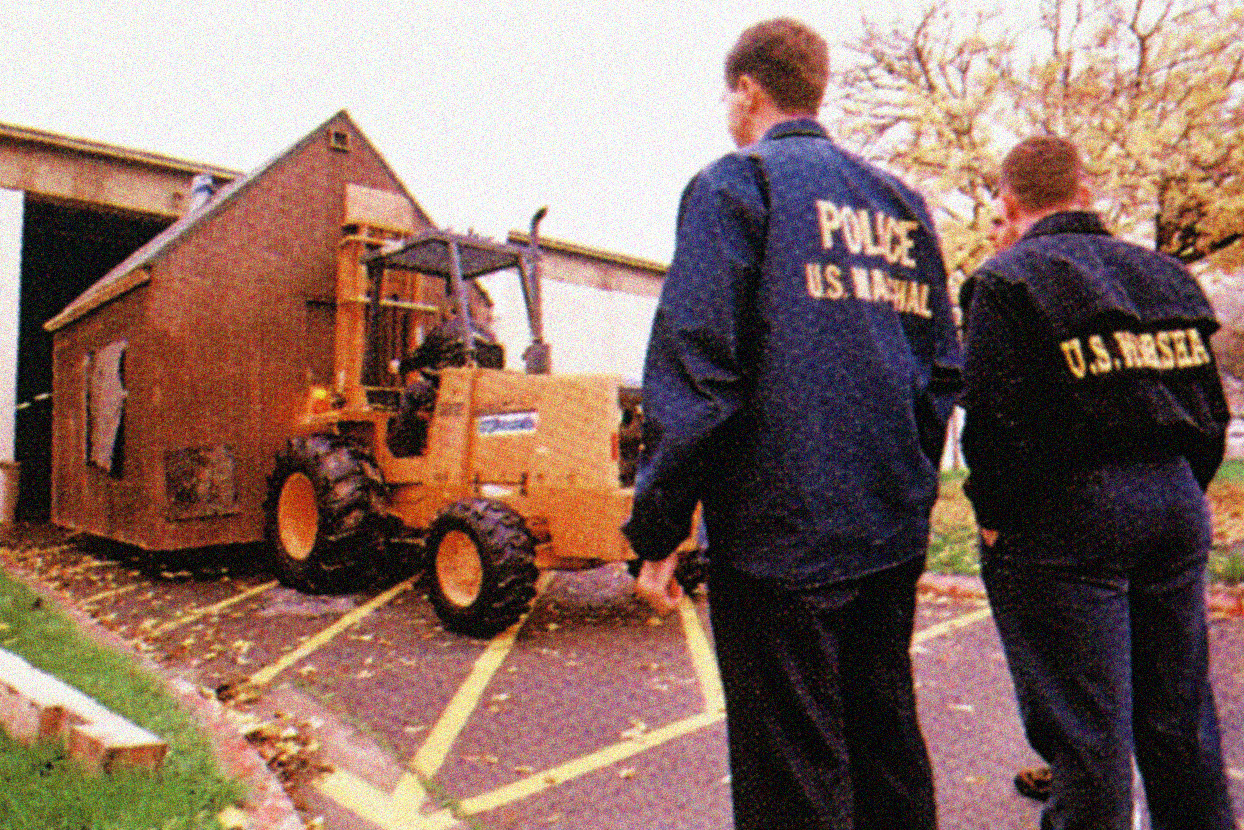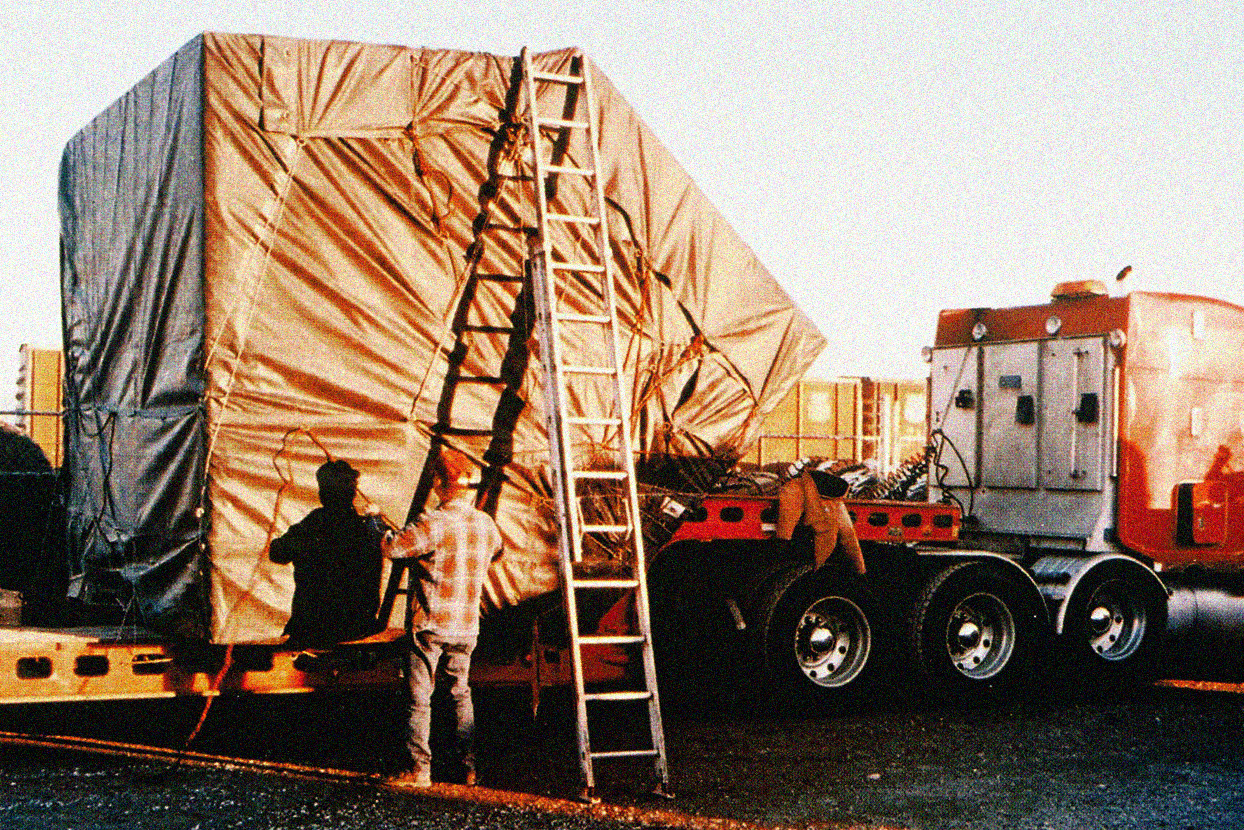Cabin Fever
The Home of the Unabomber
April 7, 2004essay,
At the end of the 1990s, the Unabomber was put on trial in the United States. His defence team tried to present his cabin as one of the most significant pieces of evidence of his insanity. The strict aesthetics of simplicity, natural materials, craftsmanship and geometric purity have since become symbolic of disturbing acts of terror, forever blemishing the image of the idyllic little house on the prairie.


December 2nd 1997. A small hut that had been hidden in the sparsely populated woods of Montana is lifted onto a flat-bed truck, covered with a black tarpaulin and transported 1100 miles to Sacramento. Shadowed by a caravan of photographers and a swarm of helicopters, it takes three days for the 10 by 12 foot wooden box to make the epic journey from isolation to metropolitan centre. For the first time, a whole building is to be presented as evidence in a court case. Architecture is brought to trial. A seemingly innocent structure is accused of sheltering the target of the biggest manhunt ever, the infamous Unabomber who had terrorized the nation for 18 years.
Not much for the jurors to look at, though. Everyone can picture the building before seeing it. Any child could draw it. Indeed, people are always drawing it, dreaming about it. The simple form plays a key role in the American imagination. The cabin in the woods is the generic retreat that is meant to tame restless city dwellers and has long been institutionalized in the camp hut, the holiday house, the fishing lodge. In fact, the Unabomber’s building is a copy of the cabin in which Thoreau so famously withdrew from the city between 1845 and 1847. It self-consciously participates in a long cultural tradition.
Yet the unique power of this form is precisely that it is not seen as a cultural artefact. It is understood to be the form that precedes the arrival of culture. The retreat is always a retreat in time, a withdrawal to a lost simplicity, purity, immediacy, harmony... a lost beginning. In the romanticized national mythology of the immigrant pioneer, the domestication of the wild by the independent settler begins with the construction of a simple domestic space using primitive means. The wooden box with a pitched roof symbolizes the moment of settling down, the erection of an isolated house in the wilderness that precedes collective settlement. The cabin is that which precedes pattern, a solitary point in an unmapped terrain. Indeed, it is the pattern of the house itself, the newly defined limits of an interior carved within an unlimited and threateningly mysterious space, that makes possible the domestication of territory and the eventual rise of settlements.
This is not simply an American fantasy. It is a generic fantasy about a generic form. Each culture dreams of the mythical isolated hut, and each has its symbolic retreats, its designated sites of withdrawal from the dominant patterns. It may not even be possible to think about the patterns without thinking of these sites. Settlement is always conceived in terms of its other.
Technology as the Enemy
The Unabomber used his settler’s cabin to unsettle the dominant pattern. His carefully written manifesto on the horrors of industrialized life condemns the modern city for its stressful, crowded existence in which people are kept prisoner under constant surveillance by police, cameras, and the manipulations of social programming. The enemy is technology, as exemplified by the computer that has united the world into a single social and spatial organization. The best solution is to go back to the purity of ‘wild nature’ in the age of the humble log cabin. Everyone should withdraw from the computer to the cabin. Within such a retreat, sixteen bombs were built and targeted with deadly effect against symbols of the technological order: computer scientists, airline executives, biogeneticists, electrical engineers. The point of the violence, said the ex-professor of mathematics, was to break society down into small units, to break the pattern.
The cabin itself is a manifesto, a puritanical polemic. No electricity or water softens the bomber’s life or connects it to the national infrastructure. The only furniture is a single chair, a small table and a bed made of a sheet of plywood covered with a thin layer of foam. There are two tiny windows. Neither provides a scenic view. One is at the top of a wall and offers a square of sky. The other, a little lower on the facing wall, monitors the access path. There is a single door at the centre and a storage loft suspended under the roof. Built by its occupant with simple tools and reused wood from an abandoned cabin, the house is immaculately constructed. The dark stained wall boards are neatly matched. Roof joists are rhythmically arranged. Windows, door and air vent are triumphs of minimalist anti-detailing. Every nail pinning down the green tar paper on the roof is exactly spaced. The house is a display of control – even if it was never meant to be seen by anyone other than its reclusive occupant.
Likewise the bombs. They had exactly the aesthetic of the house they were built in. Most were hand-crafted boxes that were carefully carved, sanded, polished and repolished – even if they would only be seen for a few moments by the victim before their devastating disintegration. Each was repeatedly taken apart, rebuilt and refinished with fetishistic but deadly care. The mechanism of the fifth one did not work and the ninth one looked suspicious, so the boxes survived. X-rays revealed that their delicate interior organization was assembled out of recycled materials held together with handmade screws and fittings. Many of the key parts were made of wood. The rest were reworked household items – untraceable because generic. The everyday as a weapon.
Symptomatically, the cabin too had to be x-rayed for fear that it was booby-trapped. Every surface was scanned for ‘secret spaces’. After all, no piece of wood could be trusted. Two of the most deadly bombs had been designed to look like simple blocks. For days, the cabin could not be entered normally. Robots were sent in through the end walls to scan each of the 700 objects found inside and, sure enough, detected a finished bomb ready for delivery. The very technologies that the Unabomber rebelled against were brought to bear on his hideaway.
A Symbol of Urban Fear
Even the woods were scanned. The FBI had taken detailed pictures from a spy satellite and laced the trees with motion detectors, microphones, television cameras and infrared scopes before waiting two months for their chance to move in. This was not simply the sudden intrusion of contemporary technology into an isolated place. Retreats are already part of the technological network, part of the pattern they seem to have escaped. Thoreau was never really isolated. On the contrary, his withdrawal was a very public act described in a best-selling book. The ideology of his cabin was actually constructed in the urban milieu. The settlement always includes within itself what it nominates as its other. ‘Isolated’ is an urban concept. It is a product of the city. To leave the map behind is a uniquely urban fantasy. It is those at the centre of the pattern that talk the most about escaping it. But their escapes are usually just extensions of the pattern, demonstrations that the city knows no limit. [This has become ever more obvious today with the rise of ecotourism, off-the-road vehicles, and wireless communication links to any point of the globe. All interiors – whether of a suburban house, a university, an airliner, or the jungle – are interconnected in multiple ways. Radical disconnection from the networks can of course occur, but anywhere, by definition. It is not a matter of leaving the city but of using the gaps in its fabric.]
The cabin in the woods is actually at the centre of the city. Far from disconnected, the terrorist ruthlessly exploited the ever-present intimate ties between isolated cell and dense urbanization. His frightening talent was the ability to hide his points of connection. While refusing to attach himself to the telephone, water and electricity lines that were only a quarter of a mile away, he kept his rural mail box on the roadside nearby, using the mail network to distribute his terror and get his manifesto published in national newspapers.
This is why a seemingly isolated hut could exemplify one of the greatest fears of urban life. The cabin has always belonged to the downtown to which it was eventually brought. It is quite at home in the public spaces of the media, including the pages of this journal. In the striking images by Richard Barnes that are presented here, the anti-technological wooden house has been lit by electronically controlled lights and photographed with a computerized camera. Every detail is ruthlessly exposed. The Sacramento warehouse in which the building still remains has been blackened out. This remobilizes the house, sending it on countless more epic journeys as we can easily see it standing on any of the sites where the archetypal form has typically been installed – whether real or imaginary.
But the all-important interior remains hidden, mysterious, threateningly obscure. The photographer, like all the journalists visiting the original site, was not even allowed to look through the windows. In over 25 years, the bomber had let only two people see inside. And it would be the interior that was on trial. The terrorist’s lawyers wanted to exhibit the actual cabin to demonstrate his insanity. They rejected the prosecutor’s conventional scale model, arguing that to be taken inside the brutally minimalist building was to be taken inside a deranged mind. The prosecutors were going to counter with photographs of the space at the time of the arrest. It was, they said, as well organized as an all-too-sane calculating mind. But the defendant preferred to plead guilty than be judged insane. The cabin was not entered and no images were ever released. The interior escapes us.
To look at these photographs is to scrutinize the exterior surfaces of an archetypal architecture for clues as to its explosive contents. The rigorous aesthetic of simplicity, natural materials, craftsmanship, and geometric purity has become an unsettling agent of horror.